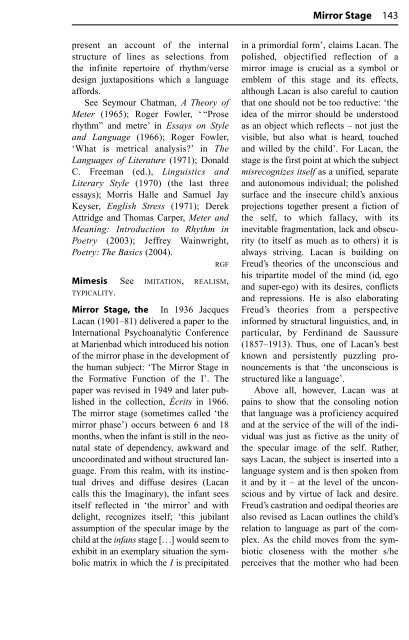The Routledge Dictionary of Literary Terms
The Routledge Dictionary of Literary Terms
The Routledge Dictionary of Literary Terms
You also want an ePaper? Increase the reach of your titles
YUMPU automatically turns print PDFs into web optimized ePapers that Google loves.
present an account <strong>of</strong> the internal<br />
structure <strong>of</strong> lines as selections from<br />
the infinite repertoire <strong>of</strong> rhythm/verse<br />
design juxtapositions which a language<br />
affords.<br />
See Seymour Chatman, A <strong>The</strong>ory <strong>of</strong><br />
Meter (1965); Roger Fowler, ‘ “Prose<br />
rhythm” and metre’ in Essays on Style<br />
and Language (1966); Roger Fowler,<br />
‘What is metrical analysis?’ in <strong>The</strong><br />
Languages <strong>of</strong> Literature (1971); Donald<br />
C. Freeman (ed.), Linguistics and<br />
<strong>Literary</strong> Style (1970) (the last three<br />
essays); Morris Halle and Samuel Jay<br />
Keyser, English Stress (1971); Derek<br />
Attridge and Thomas Carper, Meter and<br />
Meaning: Introduction to Rhythm in<br />
Poetry (2003); Jeffrey Wainwright,<br />
Poetry: <strong>The</strong> Basics (2004).<br />
RGF<br />
Mimesis See IMITATION, REALISM,<br />
TYPICALITY.<br />
Mirror Stage, the In 1936 Jacques<br />
Lacan (1901–81) delivered a paper to the<br />
International Psychoanalytic Conference<br />
at Marienbad which introduced his notion<br />
<strong>of</strong> the mirror phase in the development <strong>of</strong><br />
the human subject: ‘<strong>The</strong> Mirror Stage in<br />
the Formative Function <strong>of</strong> the I’. <strong>The</strong><br />
paper was revised in 1949 and later published<br />
in the collection, Écrits in 1966.<br />
<strong>The</strong> mirror stage (sometimes called ‘the<br />
mirror phase’) occurs between 6 and 18<br />
months, when the infant is still in the neonatal<br />
state <strong>of</strong> dependency, awkward and<br />
uncoordinated and without structured language.<br />
From this realm, with its instinctual<br />
drives and diffuse desires (Lacan<br />
calls this the Imaginary), the infant sees<br />
itself reflected in ‘the mirror’ and with<br />
delight, recognizes itself; ‘this jubilant<br />
assumption <strong>of</strong> the specular image by the<br />
child at the infans stage [. . .] would seem to<br />
exhibit in an exemplary situation the symbolic<br />
matrix in which the I is precipitated<br />
Mirror Stage 143<br />
in a primordial form’, claims Lacan. <strong>The</strong><br />
polished, objectified reflection <strong>of</strong> a<br />
mirror image is crucial as a symbol or<br />
emblem <strong>of</strong> this stage and its effects,<br />
although Lacan is also careful to caution<br />
that one should not be too reductive: ‘the<br />
idea <strong>of</strong> the mirror should be understood<br />
as an object which reflects – not just the<br />
visible, but also what is heard, touched<br />
and willed by the child’. For Lacan, the<br />
stage is the first point at which the subject<br />
misrecognizes itself as a unified, separate<br />
and autonomous individual; the polished<br />
surface and the insecure child’s anxious<br />
projections together present a fiction <strong>of</strong><br />
the self, to which fallacy, with its<br />
inevitable fragmentation, lack and obscurity<br />
(to itself as much as to others) it is<br />
always striving. Lacan is building on<br />
Freud’s theories <strong>of</strong> the unconscious and<br />
his tripartite model <strong>of</strong> the mind (id, ego<br />
and super-ego) with its desires, conflicts<br />
and repressions. He is also elaborating<br />
Freud’s theories from a perspective<br />
informed by structural linguistics, and, in<br />
particular, by Ferdinand de Saussure<br />
(1857–1913). Thus, one <strong>of</strong> Lacan’s best<br />
known and persistently puzzling pronouncements<br />
is that ‘the unconscious is<br />
structured like a language’.<br />
Above all, however, Lacan was at<br />
pains to show that the consoling notion<br />
that language was a pr<strong>of</strong>iciency acquired<br />
and at the service <strong>of</strong> the will <strong>of</strong> the individual<br />
was just as fictive as the unity <strong>of</strong><br />
the specular image <strong>of</strong> the self. Rather,<br />
says Lacan, the subject is inserted into a<br />
language system and is then spoken from<br />
it and by it – at the level <strong>of</strong> the unconscious<br />
and by virtue <strong>of</strong> lack and desire.<br />
Freud’s castration and oedipal theories are<br />
also revised as Lacan outlines the child’s<br />
relation to language as part <strong>of</strong> the complex.<br />
As the child moves from the symbiotic<br />
closeness with the mother s/he<br />
perceives that the mother who had been

















